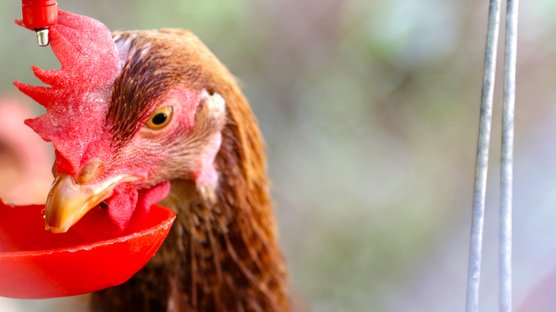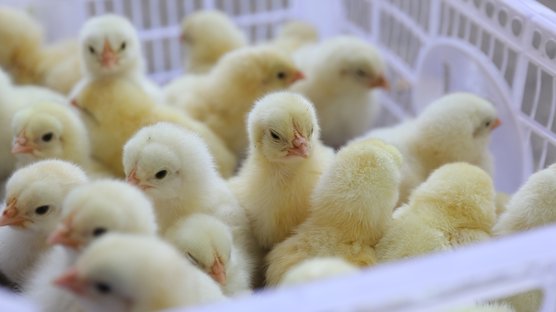
Published on July 3, 2019
Reducing the environmental impact of animal production via breeding and alternative diets
Egg production has always had an important role in the global production of foods. For decades we have been successfully selecting laying hens that efficiently produce animal protein in the source of eggs. But as the global human population is growing, and the contribution of eggs and poultry meat to the diets is increasing with even a higher rate, the environmental impact of food production has become an important sustainability issue.
Although the chicken egg and broiler meat supply chains have relatively low emissions, the scale of both sectors and the rate of growth require a further reduction in emission intensity. The contribution of the emission of greenhouse gasses to global warming and the increased depletion of scarce resources, like phosphorus, are part in today’s discussion on how viable animal protein production is in feeding the global population in a sustainable way for now and in the future.
When looking to egg production, the production of feed for the laying hens contributes over 69 percent of emissions, the direct on-farm energy use 4 percent, post-farm processing and transport 6 percent and the storage and the processing of the manure 20 percent (MacLeod et al., 2013).
The production of poultry meat has higher feed emissions than those of eggs, this can be partly explained by the higher share of soybean in the bird’s diets. As of this higher share of soybean, on average more soybean is sourced from areas where a change in land-use (LUC) is taking place. A clear example of LUC is the conversion of forest into agricultural land in the Amazon rainforest. As a consequence, LUC accounts for 21 percent of poultry meat emissions and 13 percent of egg emissions (MacLeod et al., 2013).
From the Global Life Cycle Assessment, performed by the FAO in 2013, they estimated that chicken supply chains are estimated to produce 58 million tonnes of eggs and 72 million tonnes of carcass weight per year. In relation to that, the yearly excreted GHG emissions of CO₂ were estimated to be 606 million tonnes. The calculated average emissions intensities of chicken meat were 5.4 kg CO₂-eq / kg Carcass weight, and 3.7 kg CO₂ -eq / kg eggs.
Feed production is the main source of GHG-emissions, by selection for improved feed conversion rate (FCR), e.g. the amount of feed needed to produce 1kg of eggs, we can directly lower the environmental impact of egg production. Besides selecting for improved FCR, we are also selecting for birds that can maintain their egg production on diets that contain lower feed quality ingredients, like by-products or residual flow products. A clear example that our birds can perform well on these diets are the Dekalb White birds at Kipster. At Kipster, they feed the birds with a new, specially developed feed made from the residual flows of, for example, large bakeries. Their chicken feed exists for 97% of leftovers and 3% of vitamins and minerals. They state that the CO₂ footprint of a kilo Kipster feed is 50% smaller compared with standard chicken feed.
In Europe, the use of soybean in poultry diets is becoming increasingly under pressure. The poultry industry collectively consumes the most soybeans of any livestock sector in Europe (van Gelder et al., 2008). Besides the EU is very heavily reliant on the import of soybeans from the Southern Americas. The FEFAC 2012 statistical yearbook showed that in 2012, the European self-sufficiency of soya bean meal was only 3%, while it accounts for 64% of the protein-rich feed materials (De Visser, 2014). Soya bean meal is a major source of the essential amino acid lysine, which is after Methionine the second limiting amino acid. Next to the negative impact on the change in land-use in the southern Americas, the dependence of imports leaves the EU exposed to unexpected changes in feed prices and ingredient scarcity. At the moment the existing substitutes for soybean products in the European poultry diets are rather limited, the production of soybean in Europe is insufficient and there is not much progress yet in scaling this production up, as the right varieties to grow soybean efficiently in Europe are still lacking. The use of fishmeal cannot be a full substitute for all the protein from soybeans and the use of proteins derived from processed animals is still banned as of the crises with BSE and Scrapie.
According to Józefiak and Engberg (2015), there is no doubt that insect meals are suitable for the feeding of poultry from a nutritional perspective. But, a barrier for the inclusion of insects in livestock diets is the present EU legislation (Regulation (EC) No. 1069/2009), where insect meals are defined as processed animal protein (PAP). Insects are classified as Category 3 material (fit but not intended for human food chains). As such, they are suitable as feed for livestock in particular for fish, poultry and pigs. However, despite Regulation (EC) No. 1069/2009, Regulation (EC) No. 999/2001 prohibits the feeding of farmed animals with PAPs. Now, egg producers only have the option to feed their birds with “live” insects, as they do not fall under the definition of a PAP, due to logistics the use of processed insect protein is preferred. The international platform of insects for food and feed (IPIFF) is an EU non-profit organization which promotes the use of insects for human consumption and insect derived products as a top tier source of nutrients for animal feed. Due to their intensive lobby it is on the EU agenda in Brussels and this could result that in the nearby future legislation might be changed in the favor of allowing processed insects in poultry diets.
As in the future, the impact of animal production on the environment and available feed protein sources will become even more important than as it already is today, it is of great importance that we can breed birds that are able to produce efficient and sustainable. By selecting birds based on their feed conversion ratio measured when fed with diets that contain more and more by-products we are able to breed for birds that can still produce efficiently if you reduce the percentage of soya bean meal in the diets and replace it via alternative sources of protein like processed insects.
References
Józefiak, D., Engberg, R.M., (2015) Insects as poultry feed, 20th European Symposium on Poultry Nutrition, August 24-27 2015,Prague, Czech Republic
MacLeod, M., Gerber, P., Mottet, A., Tempio, G., Falcucci, A., Opio, C., Vellinga, T., Henderson, B.
& Steinfeld, H. (2013) Greenhouse gas emissions from pig and chicken supply chains – A global life cycle assessment. Food and Agriculture Organization of the United Nations (FAO), Rome.
Van Gelder J.W., Kammeraat K, Kroes H., (2008) Soy consumption for feed and fuel in the European Union. ProfundoEconomic Research. Profundo, Castricum, the Netherlands.
De Visser, C.L.M. , Schreuder, R., Stoddard, F., (2014) The EU’s dependency on soya bean importfor the animal feed industry and potential for EU produced alternatives. OCL 2014, 21(4) D407



